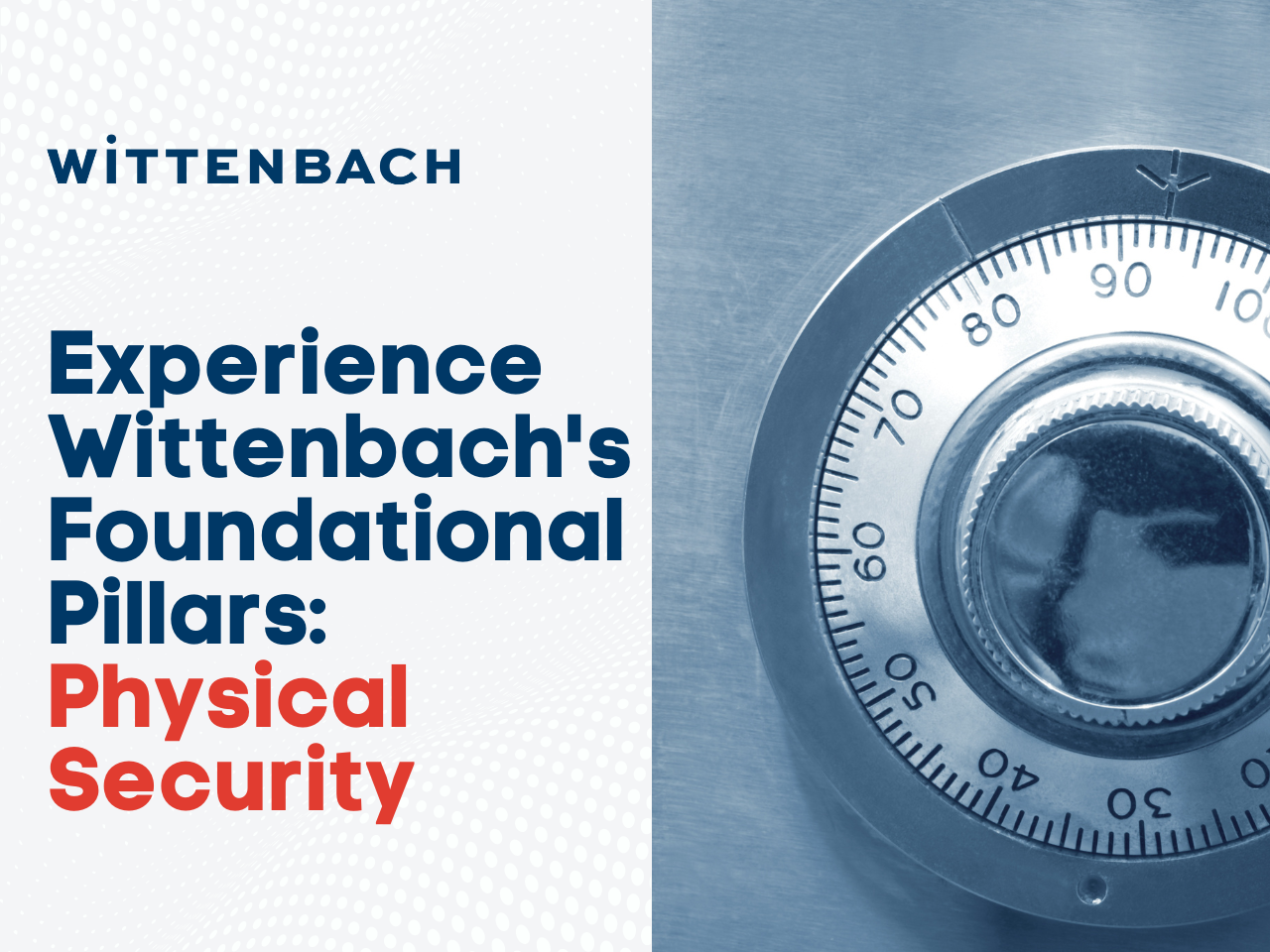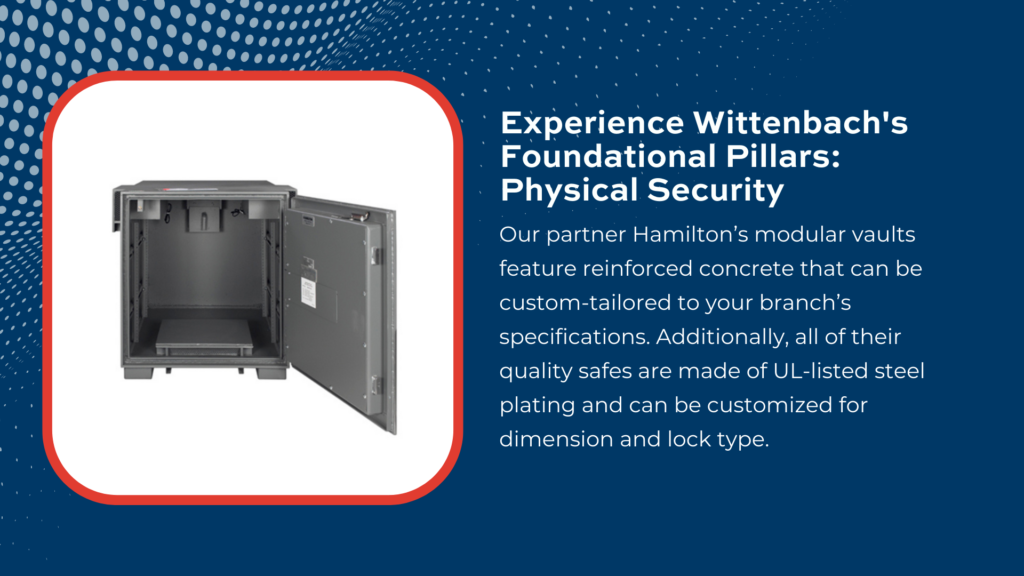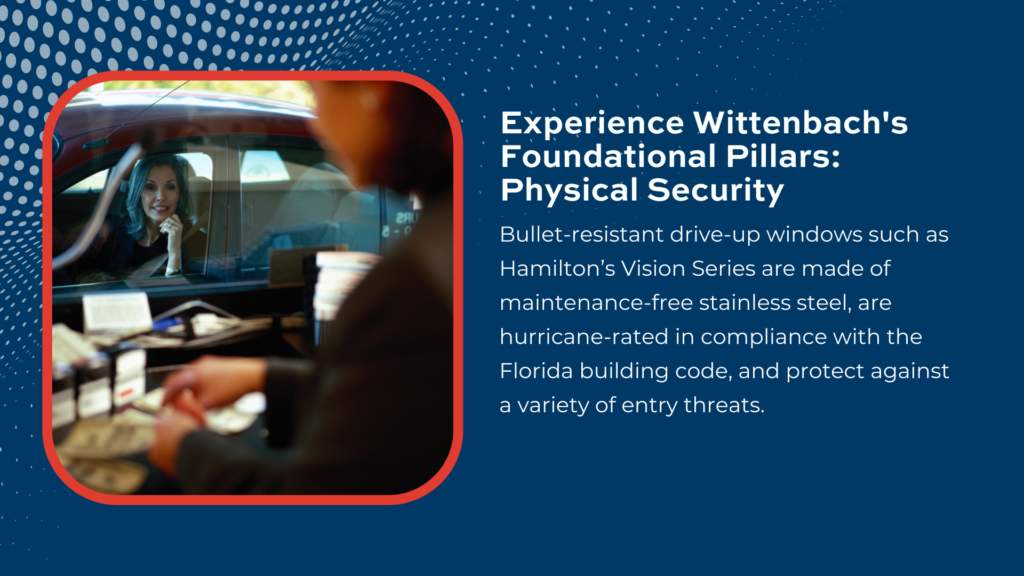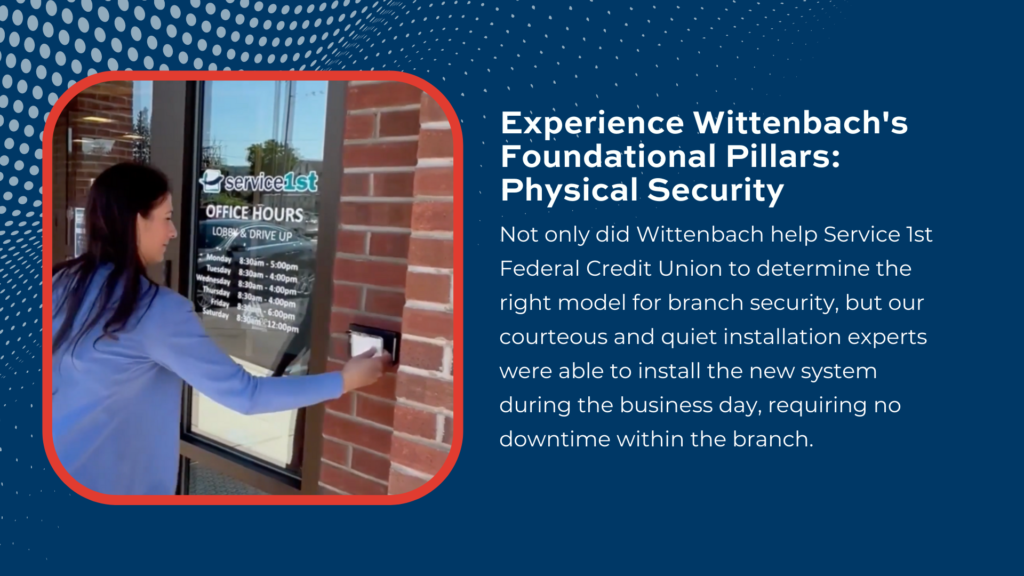Achieving and maintaining the physical security of your financial institution can be a moving target, as both new technology and new vulnerabilities evolve. Bearing in mind customer, asset, and employee security, outfitting your branch with the right products, services, and employee training can make a measurable difference. With physical security as one of Wittenbach’s four main foundational pillars and product lines, our expertise and practical experience runs deep. Our solutions and partnerships offer protection inside and outside your branch, controlling the flow of traffic and preventing loss from crime and environmental disasters.
Why do we focus on physical security?
If your staff, customers, and assets are not comfortably protected, then a need exists to optimize. Physical security has become a pillar for Wittenbach as numerous branches have called upon us to get their safes, deal drawers, and drive up lanes to be in service for their clients. Branches call Wittenbach because they know that the Wittenbach service technicians have the skills and parts available to make sure the branch stays open and functions properly. Many times Wittenbach technicians have outperformed the competition which allows branches to keep their regularly scheduled hours and keep their clients happy.
While our roots are in the financial sector, security is important in numerous highly sensitive or high-traffic settings: hospitals, schools and campuses, manufacturing facilities, government buildings, laboratories, pharmacies, and more. Below, we’ll outline the products and manufacturers that can best support your security efforts, as well as resources that can empower your employees in the event of an issue.
Vaults and Safes: These are arguably the most important protective devices in a financial institution. Vaults are typically installed prior to building construction, with reinforced concrete panels that are designed to withstand intruders, extreme weather conditions, fire, earthquakes, and even a nuclear attack. Safes can hold cash and other smaller valuables, while vaults store safe deposit boxes, sensitive documents, and other larger valuables. Our partner Hamilton’s modular vaults feature reinforced concrete that can be custom-tailored to your branch’s specifications. Additionally, all of their quality safes are made of UL-listed steel plating and can be customized for dimension and lock type.
Access Control Systems: These security systems allow user- or permission-based access to lock and unlock your buildings. Modern solutions such as the DMP Virtual Keypad allow for access control from anywhere, on any mobile device, eliminating the need for traditional keys and allowing for easy management as employees come and go.
Lockers: A smaller locker unit can keep cash and small valuables secure, while also fitting into the aesthetic of your branch building. Hamilton offers lockers that can be configured with combination locks, electronic locks, or time-delay locks for optimal security. The manufacturer says, “Hamilton lockers provide the security and selection banks need for storing cash and coins. We can build just about any size, shape, or finish of a security locker. Choose from a wide range of predetermined modular sections that are available in your choice of solid steel painted or stainless steel clad doors. Even with Hamilton’s Modular Lockers, you can still select the type of lock and paint color.”
Safe Deposit Boxes: An individually secured safe deposit box is housed inside a safe or vault, protecting customers’ assets such as important documents, jewelry, and treasured family heirlooms. Along with the structures that house them, safe deposit boxes are designed to resist criminal activity and environmental disasters. Per Wittenbach Team Leader and physical security expert Russell Luczak, a bank or credit union must open the safe deposit box initially with their key, but the customer’s key is required for all subsequent entries. Luczak adds, “A lost customer key will always require a forced entry by a trained technician.” Hamilton manufactures safe deposit boxes from stainless steel in a variety of sizes that can be rearranged and re-numbered to best fit the safe or vault they occupy.
Bullet-Resistant Glass: A robbery at your bank or credit union is much less likely to happen than the movie industry would admit. FBI crime reporting indicates that only 1.4% of annual robberies are committed in financial institutions. However, since your branch contains a significant amount of money and valuables, as well as priceless employees and clients, it is best practice to be adequately prepared for any type of security breach. Bullet-resistant drive-up windows such as Hamilton’s Vision Series are made of maintenance-free stainless steel, are hurricane-rated in compliance with the Florida building code, and protect against a variety of entry threats. These window panels can also be easily integrated with the Hamilton transaction drawers or “deal drawers”, which allow for the secure exchange of cash and documents in drive-thru lanes.
Hold-up Buttons: Again, a robbery is unlikely. However, a hold-up button can support your branch in the event of a breach. We outlined the main functionality of hold-up buttons in a recent blog post: “Hold-up buttons can come in all different shapes and sizes. The trigger could be a push button, electronic money clip, a foot rail, or a number of other things. In some cases, hold-up buttons are connected to wireless speakers inside your company or financial institution.” Our partnership with manufacturer DMP means that it’s easier than ever to purchase and install a hold-up button, including their wireless 1142 Series. This innovative hold-up button operates within uncluttered frequencies, features a tamper-proof case, and offers superior battery life to keep your financial institution safe. The city of Frederick, Maryland offers a false alarm prevention guide, with best practices on when to activate your hold-up button and when to call emergency services instead.
Three resources to learn more about physical security
- This use-case testimonial from Service 1st Federal Credit Union describes the financial institution’s need for an updated access control system. Not only did Wittenbach help them to determine the right model for branch security, but our courteous and quiet installation experts were able to install the new system during the business day, requiring no downtime within the branch. Client Dave Shope, AVP of Business Development & Security, describes the journey of retrofitting their branches, which had varying levels of access control.
- This compliation of training resources from the Independent Community Bankers of America offers training on physical security technology, as well as threat prevention and response. Course titles include “Workstation Security for Bank Employees”, “Robbery Prevention and Response Training”, “Active Shooter Emergency Plan”, and many more.
- The Association of Banks in Singapore (ABS) offers this online guide that provides instruction on threat and vulnerability risk assessment, protection, detection, and response; all of these are critically important subjects to supplement the training and technology used to protect your branch or business.
Now that you have both a broader and deeper understanding of Wittenbach’s physical security capabilities, contact us today to help plan your next project. Our experts can help you choose the right technology to protect your space, and install it even during working hours, simultaneously providing value and minimal disruption. Whether you need to reinforce the interior or exterior of your branch, our knowledge and partnerships provide the modernized security and peace of mind you’re seeking.




